#M. Welte & Sons New York
Text
M. Welte & Sons, New York
The German firm M. Welte & Söhne, Freiburg (1832-1951) was a manufacturer of orchestrions, organs and reproducing pianos, established in Vöhrenbach in 1832 by Michael Welte (1807-1880). M. Welte & Sons in New York was the American subsidiary of M. Welte & Söhne, founded by Emil Welte in 1866 and managed by him until 1912. The branch office in New York served primarily the sale of the Orchestrion produced in Germany and for the support of US customers.
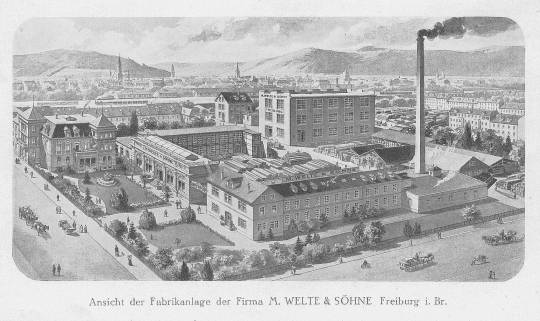
Factory building of M. Welte & Söhne in Freiburg (ca. 1912)
From 1832 to 1932, the firm produced mechanical musical instruments of the highest quality, primarily the development and construction of orchestrions from 1850 up to the early 20th century. In 1872, the firm moved from the remote Black Forest town of Vöhrenbach into a newly developed business complex beneath the main railway station in Freiburg, Germany. Their major breakthrough was substituting perforated paper rolls for wooden pin-studded cylinders.
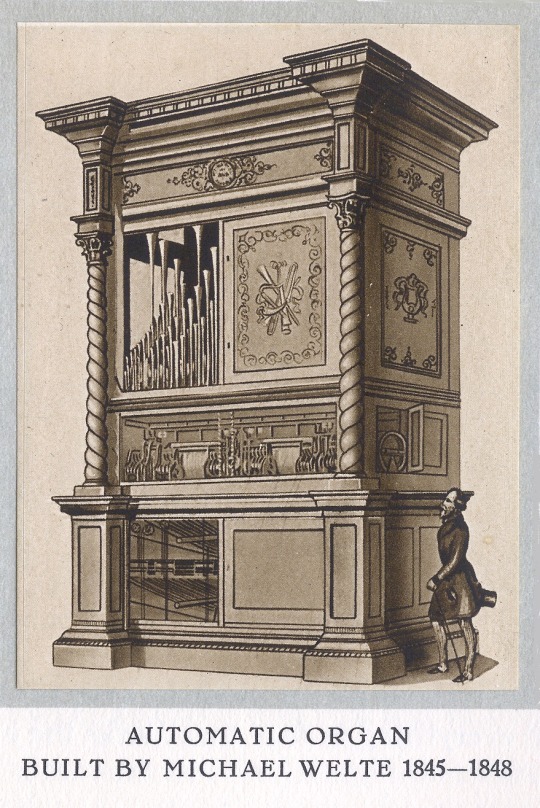
Emil Welte (1841-1923), the eldest son of Michael, had immigrated to the United States in 1865. In 1883 he patented the paper roll method (U.S. Patent 287,599), the model of the later piano roll. Welte began only building instruments using the new technique, which was also licensed to other companies. With branches in New York and Moscow and representatives throughout the world, Welte became very well known.
The firm was already famous for its inventions in the field of the reproduction of music when Welte introduced the Welte-Mignon reproducing piano in 1904. “It replayed automatically the tempo, phrasing, dynamics and pedaling of a particular performance and not just the notes of the music as it was the case with other player pianos at the time.”
In September 1904, the Mignon was presented at the Trade Fair in Leipzig. In March 1905, it became better known when showcased “at the showrooms of Hugo Popper, a manufacturer of roll-operated orchestrions”.
By 1906, the Mignon was also exported to the United States and installed in pianos by the firms Feurich and Steinway & Sons. As a result of this invention one could now record and reproduce the music played by a pianist as true to life as it was technologically possible at the time.
Welte Philharmonic Organ
From 1911 on, a similar system was developed for organs of the brand “Welte Philharmonic-Organ”. Thirteen well-known European organist-composers of the era, among them Alfred Hollins, Eugene Gigout and Max Reger, were photographed while recording for this organ. Distinguished organists like Edwin Lemare, Clarence Eddy and Joseph Bonnet were recorded too.
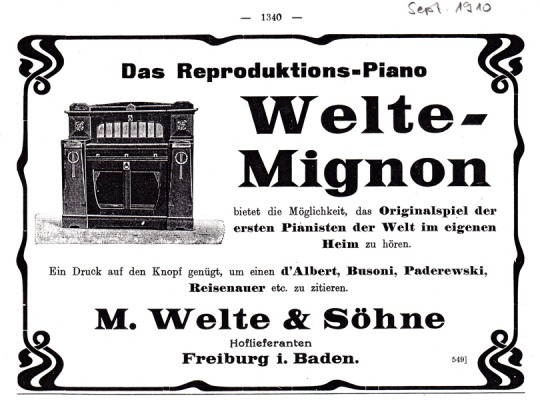
The largest Philharmonic Organ ever built is to be seen at the Salomons Estate of the Markerstudy Group, built in 1914 for Sir David Lionel Salomon. One of these organs can also be seen in the Scotty’s Castle museum in Death Valley, where it is played regularly during museum tours. An organ built for the HMHS Britannic never made its way to Belfast due to the outbreak of the First World War. Today it is playing in the Swiss National Museum in Seewen.
M. Welte & Sons, Inc.
In 1912, the American subsidiary of M. Welte & Söhne became M. Welte & Sons, Inc., a company incorporated in New York. Shareholders of the new company were predominant family members in the U.S. and Germany, among them Barney Dreyfuss, Edwin’s brother-in-law.
The Welte Artistic Player Co, founded in 1906 by Edwin Welte and Karl Bockisch for the distribution of Welte-Mignon instruments, merged with the new company. In the same year a new factory building was established in Poughkeepsie, New York on the New York Central Railroad line.
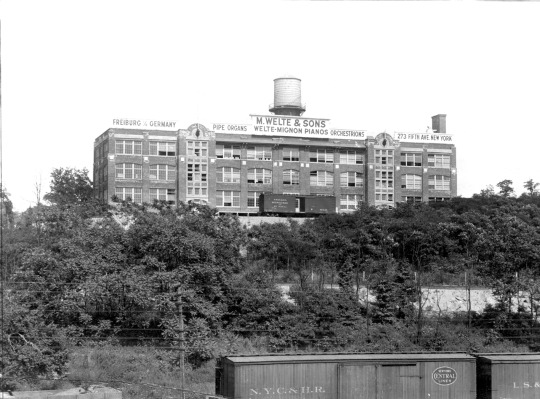
Welte manufacturing building in Poughkeepsie, N.Y.
The high customs for the import of complete instruments from Germany could be significantly reduced by the mixed manufacture from German and American parts. Up to 1914, about 30 philharmonic organs were installed in the USA, mostly in the private homes of super-rich people.
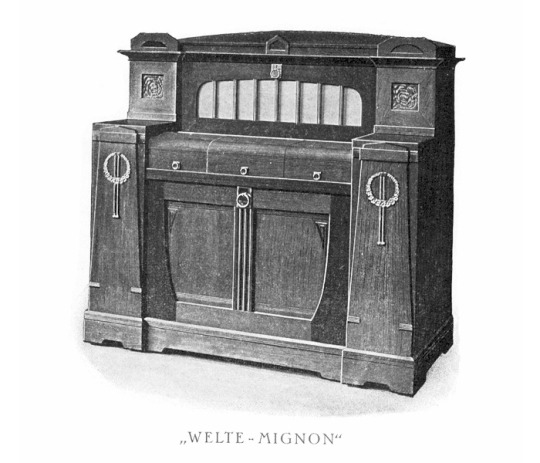
The Welte-Mignon player piano
Great War in Europe and Events in America, Decline and Bankruptcy
With the entry of the U.S. into the First World War the German property and U.S. patents of M. Welte & Sons., Inc. were confiscated in April 1917 under the Alien Property Custodian Act and publicly auctioned in March 1919. The company was sold by the new owners in May 1919 to George W. Gittins, who sold the plant in Poughkeepsie. The company name M. Welte & Sons, Inc., New York had been changed to Welte-Mignon Corporation and was later controlled by the Estey-Welte Corporation founded in 1922.

The complex playing mechanism of the Welte instruments.
The post-WW I depression and new technologies like the radio and the electric record players in the 1920s virtually brought about the extinction of the firm and its expensive instruments. Other companies with similar products like American Piano Co (Ampico) and Duo-Art also began to disappear from the scene.

Estey-Welte Corporation, New York, B-stock certificate number B0885, 35 shares, issued to George Lindley on November 29, 1926.
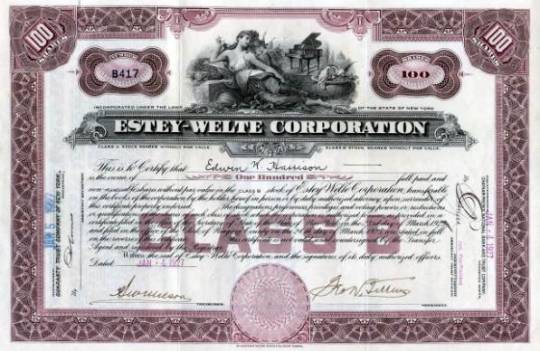
Estey-Welte Corporation, New York, B-stock certificate number B417, 100 shares (ex LaBarre Rarities 4 and scripophily.com). Also known is an odd-lot certificate of the same type in blue, serial no. B885. “Class A” stocks are known. There is an odd-lot in green serial no. A1245 and another was sold in 1994 Smythe auction 129 lot 2101(#A4234, creased). Several Class A 100 shares in orange are known, including serial no. A488. All of these were printed by the Hamilton Bank Note Co.
The difficult business situation led to a reorganization of the Estey-Welte Corporation in 1927. The company’s name changed to Welte Co, Inc., (DE). By November 1927, Welte Co, Inc., and the Welte-Mignon Corporation were in serious financial difficulties.
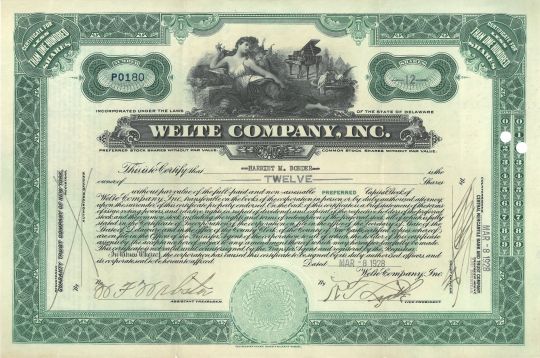
Welte Company, Inc., Delaware, preferred stock certificate number P0180. The Welte stock certificates were issued during the reorganization of the Estey-Welte Corporation and the simultaneous modification of the Estey-Welte Corporation’s name to the Welte Company, Inc. during the period January to June 1927. An odd-lot common certificate is known of the same type in blue, serial no. C074.
In 1928, the companies were acquired and reorganized by the investment bank Morton, Lachenbruch & Co as the Welte-Mignon Corporation (DE). In 1929 the newly founded company became insolvent and it was acquired by Donald F. Tripp. Subsequent the company became the Welte-Tripp Organ Corporation. This company went bankrupt in 1931. Donald Tripp handed the Welte organ division to the “W. W. Kimball Company”, an organ builder in Chicago, Illinois.
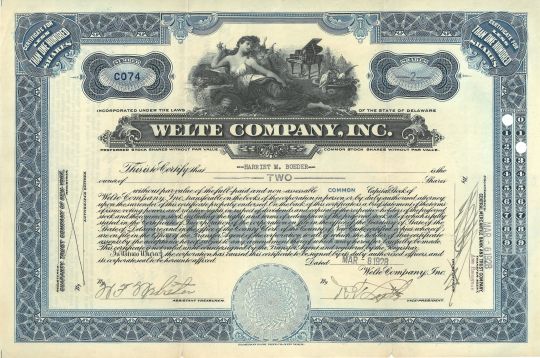

Welte-Mignon Piano Corporation, New York, stock certificate issued 24 April 1930, bearing the signature of Otto Kremp, President.
The traces of the American Welte companies were lost. Only two service companies named Welte-Mignon Piano Corporation and Welte-Mignon Piano Service Co (managed by the former Welte Freiburg employee Otto Kremp), still existed in the 1940s.
The business complex of M. Welte & Söhne in Freiburg was bombed and completely destroyed in November 1944. This event seemed to obliterate the closely kept secrets of the firm and their recording apparatus as well as the recording process. But in recent years parts of the recording apparatus of the Welte Philharmonic-Organs and documents were discovered in the US. It was then possible to theoretically reconstruct the recording process. The Augustiner Museum of Freiburg keeps the legacy of the company that survived the Second World War.
Based on current information the scripophily of the Welte companies (illustrated) is all scarce to rare.
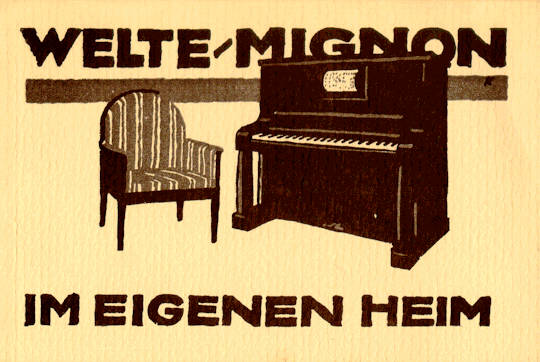
A Short History of the Welte-Mignon in USA … see here
-
Hans-Georg Glasemann
I am a collector of historical securities and active in the collectors club EDHAC. Support the EDHAC, become a member...
If you want to subscribe to the Nonvaleurs blog free of charge, click "RSS feed" in the upper right corner. Older contributions to the blog can be found by clicking "Archive"!
Source: Wikipedia and HGG (F9/21-1/2017). Many thanks to Max Hensley IBSS for revising this text.
1 note
·
View note
Text
El escenario está listo para el vehículo y el equipo con el que BMW ingresará en el Campeonato de ABB Fórmula E de la FIA a partir de la temporada 5. Este viernes, BMW i Motorsport presentó el nuevo BMW iFE.18 y el nuevo equipo BMW i Andretti Motorsport en BMW Welt en Múnich, Alemania. El vehículo de carreras totalmente eléctrico impresiona con un diseño fascinante, mientras que la obra maestra del BMW iFE.18, el innovador tren motriz, se esconde en el interior.
El tren de rodaje se desarrolló utilizando la experiencia de los mismos ingenieros que diseñaron los componentes del BMW i3. BMW i y BMW Motorsport están trabajando muy de cerca en el proyecto de Fórmula E, lo que facilita una transferencia de tecnología entre el desarrollo sin precedentes de los vehículos de producción en serie y el deporte motor.
Los dos vehículos BMW iFE.18, que estarán en acción para BMW i Andretti Motorsport, en las carreras de Fórmula E en todo el mundo, a partir de diciembre, contarán con los pilotos de fábrica de BMW António Félix da Costa, originario de Portugal, y Alexander Sims, originario de Gran Bretaña, al volante
“La Fórmula E no es sólo una serie de carreras innovadora y espectacular que se ha establecido como una de las mejores series de carreras del mundo, con un enfoque totalmente nuevo en sustentabilidad y eventos en pocos años”, dijo Klaus Fröhlich, miembro del Consejo de Administración de BMW AG, para Desarrollo y Motorsport, quien inauguró la presentación del BMW iFE.18 frente a representantes de los medios, socios y otros invitados de todo el mundo. “Para BMW, también es el laboratorio de pruebas perfecto para el desarrollo de producción. La transferencia de tecnología entre el deporte motor y la producción en serie es intensa. Nuestra experiencia de producción en serie beneficia el tren de rodaje del vehículo de carreras. Al mismo tiempo, las ideas de la Fórmula E fluyen directamente en el desarrollo de futuros trenes de rodaje de producción en serie. Por lo tanto, estoy deseando que llegue una gran temporada de carreras “.
Pieter Nota, miembro del Consejo de Administración de BMW AG, Ventas y Marca BMW, explicó la importancia de la participación de Fórmula E para la marca BMW y dijo: “BMW es sinónimo de liderazgo innovador. Somos pioneros en movilidad eléctrica. Fuimos convencidos por la Fórmula E desde el principio y como “Socio oficial de vehículos” hemos estado involucrados desde el principio, para ayudar activamente a dar forma a la serie. BMW i y Fórmula E comparten los mismos valores: espíritu pionero e innovación “.
Para obtener la máxima potencia en la Fórmula E: el tren de rodaje BMW i.
En el BMW iFE.18, el espíritu pionero, la innovación y la experiencia tecnológica de BMW Motorsport y BMW i se unen. El uso del conocimiento y la experiencia de los ingenieros de BMW i en la producción en serie dio como resultado el tren de rodaje del nuevo vehículo de Fórmula E. En parte, se usan las mismas plantas de producción que para el BMW i3. La colaboración entre el deporte del motor y el departamento de producción en serie funciona como un ciclo eficiente. Los hallazgos de la Fórmula E fluyen directamente hacia el desarrollo de futuros trenes de rodaje en serie de los próximos modelos de BMW i.
“La experiencia de BMW en el BMW iFE.18 está principalmente en el corazón del vehículo: el tren de rodaje”, dijo el director de Motorsport de BMW, Jens Marquardt. “Le dijimos a los ingenieros de producción que diseñaron el motor eléctrico y el inversor: “Olvídense de todas las consideraciones que normalmente se tendrían en el desarrollo, y sólo piense en el rendimiento, la mayor eficiencia y el menor peso. Cuando hayamos llegado a ese punto, podremos pensar cómo integrarlo en la producción en serie más adelante. Nuestros ingenieros de BMW Motorsport diseñaron el eje trasero, incluida la suspensión, y tuvieron que integrar el tren de rodaje en la parte trasera del vehículo de carreras. El conocimiento que obtenemos en este entorno altamente competitivo fluye directamente al desarrollo de la producción. Esta es la implementación perfecta de nuestro lema: de la pista de carreras a la carretera “.
Una perspectiva única para correr en las calles.
El diseño del BMW iFE.18 está definido por el contexto urbano de la Fórmula E. “Las carreras de Fórmula E se celebran en circuitos estrechos en los centros de las ciudades y reconocemos que los espectadores suelen ver los coches desde posiciones más altas y cercanas a la pista. que muchas otras formas de carreras “, dijo Michael Scully, jefe de diseño de BMW Motorsport. “Adoptamos esa constelación única, y la vista superior del automóvil es donde comenzamos: establece el esquema general de la imagen del BMW iFE.18”.
Los icónicos cuadros azules y blancos del logotipo de BMW son la base de una composición a escala real; estructurando cada vista clave del BMW iFE.18. La secuencia alterna de colores y formas contrastantes proporcionan la máxima visibilidad a velocidades de carrera y hacen que el BMW iFE.18 sea inconfundiblemente un BMW. El osado diseño asimétrico también comparte el elemento de la cabina en color negro no reflectante, derivado de la funcionalidad, visto en la decoración de BMW M Motorsport 2018.
Un degradado de color desde azul claro en la parte delantera del vehículo hasta azul oscuro en la parte posterior transmite el movimiento y la transición: ambos temas relevantes en el contexto de la movilidad eléctrica. Incluido dentro de la imagen, hay una red de gráficos conectivos de “venas” azules y moradas que llevan los colores naturales de la electricidad cruda en todo el BMW iFE.18. Ocasionalmente, las “sinapsis” púrpuras se propagan en las intersecciones de la red y crecen en número cerca del tren de rodaje de BMW i. En el BMW iFE.18, no hay dos perspectivas iguales, literalmente.
Equipo experimentado, conductores experimentados.
Los dos vehículos BMW iFE.18 serán desplegados por BMW i Andretti Motorsport con el director del equipo Roger Griffiths, originario de Gran Bretaña, a la cabeza. Griffiths y el equipo Andretti Autosport, propiedad de Michael Andretti, originario de Estados Unidos, aportan una gran cantidad de experiencia en la Fórmula E. El equipo estadounidense ha disputado todas las carreras de la serie desde 2014. “No veo la hora de ver a BMW i Andretti Motorsport llegar a las pistas en la temporada 5. Creo que tenemos los socios, pilotos y personal adecuados para competir en el nivel más alto de la Fórmula E “, comentó el CEO de Andretti Autosport, Michael Andretti. “Todos en ambos lados se han dedicado al desarrollo del nuevo BMW iFE.18 y espero verlo en acción. Estamos entrando no sólo en una nueva era de Fórmula E, sino del deporte motor en general “.
António Félix da Costa también ha estado en acción en la Fórmula E desde la temporada 1, y conducirá el BMW iFE.18 #28 en la próxima temporada. “Conozco la Fórmula E realmente bien y siempre estuve convencido de que BMW entraría como fabricante algún día. Ahora, ser parte de este equipo es un motivador increíble “, dijo Félix da Costa.
Alexander Sims en el auto #27 competirá junto a Félix da Costa. Sims, así como Félix da Costa, ha demostrado su excepcional versatilidad como piloto de BMW durante muchos años y ha celebrado innumerables éxitos en los vehículos de carreras de BMW. “La Fórmula E se ha convertido rápidamente en el lugar idóneo para los mejores fabricantes y los mejores pilotos. Es un honor para mí, el ser confiado con esta aventura en colaboración con BMW i Motorsport “, comentó Sims.
Codo a codo con socios fuertes.
Otra parte importante de BMW i Andretti Motorsport son los socios que apoyan el proyecto. El socio principal de BMW i Motorsport es Magna. El proveedor automotriz mundial para tecnologías futuras tiene una asociación duradera con BMW. Magna utilizará la plataforma de Fórmula E como catalizador para investigar soluciones innovadoras en materia de movilidad. Julius Baer, miembro fundador de la Fórmula E, ha formado parte de la familia de BMW i Motorsport desde el principio. El grupo bancario privado suizo ampliará su relación con BMW, uniéndose al equipo como el Socio Principal de Capital. El nuevo socio principal del equipo es Einhell, fabricante de herramientas eléctricas innovadoras y sustentables, así como herramientas y accesorios para jardín. Harman Kardon, el socio de BMW desde hace mucho tiempo para soluciones Premium de audio, continuará la relación con BMW i Motorsport como socio oficial. PUMA es el Proveedor Oficial.
Lanzamiento virtual del BMW iFE.18.
Los fanáticos de las carreras de todo el mundo pudieron seguir la presentación del nuevo auto de Fórmula E en vivo en los canales de redes sociales de BMW Motorsport. Parte del programa fue un video de lanzamiento de 2.8 segundos, que es exactamente el tiempo que le toma al BMW iFE.18 pasar de 0 a 100 km / h. Si bien la versión corta del clip fascina con su velocidad extrema, el mensaje completo sólo se desarrolla en una versión futura, muy ralentizada.
El BMW iFE.18 disputará su primera carrera alrededor del mundo horas más tarde, durante la noche. El viernes a partir de las 19:30 hrs. CEST, los visitantes del BMW Welt podrán tomar una foto del automóvil nuevo y Sims y Félix da Costa estarán en el lugar para firmar autógrafos. Presentado por un fascinante espectáculo de luz y láser en el frente del BMW Welt, el BMW iFE.18 realizará su recorrido virtual por las calles de Munich a las 22:00 hrs. CEST, utilizando la tecnología de mapeo de movimiento.
En las próximas semanas, este espectáculo también atraerá la atención de personas en Oslo (Noruega, 17/9), Londres (Gran Bretaña, 20/9), Nueva York (Estados Unidos, 24/9), Detroit (Estados Unidos, 26/9). ), Ciudad de México (México, 29/9) y Hong Kong (China, 4/10). La primera carrera real para el BMW iFE.18 y BMW i Andretti Motorsport está programada para el 15 de diciembre de 2018 en Al-Diriyah, Arabia Saudita.
The new BMW iFE.18 for the ABB FIA Formula E Championship (09/18).
The new BMW iFE.18 for the ABB FIA Formula E Championship (09/18).
The new BMW iFE.18 for the ABB FIA Formula E Championship (09/18).
The new BMW iFE.18 for the ABB FIA Formula E Championship (09/18).
The new BMW iFE.18 for the ABB FIA Formula E Championship (09/18).
The new BMW iFE.18 for the ABB FIA Formula E Championship (09/18).
The new BMW iFE.18 for the ABB FIA Formula E Championship (09/18).
The new BMW iFE.18 for the ABB FIA Formula E Championship (09/18).
Listos para la temporada 5 del Campeonato ABB Fórmula E de la FIA: el vehículo BMW iFE.18 El escenario está listo para el vehículo y el equipo con el que BMW ingresará en el Campeonato de ABB Fórmula E de la FIA a partir de la temporada 5.
0 notes
Text
M. Welte & Sons
M. Welte & Sons in New York war die US-Niederlassung des Unternehmens M. Welte & Söhne in Freiburg (1832-1951). Die amerikanische Niederlassung wurde 1866 von Emil Welte gegründet und von ihm bis 1912 geführt. Die Niederlassung in New York diente zuerst vor allem dem Verkauf der in Deutschland produzierten Orchestrien sowie der Betreuung der zahlreichen Kunden in den USA.

Fabrikgebäude von M. Welte & Söhne in Freiburg (um 1912)
1912 wurde die Firma Teil der neu gegründeten M. Welte & Sons, Inc., einer Aktiengesellschaft mit Sitz in New York. In dieser Gesellschaft ging auch die 1906 zum Vertrieb der Welte-Mignon-Reproduktionsklaviere von Edwin Welte und Karl Bockisch gegründete Welte Artistic Player Company auf.

Im selben Jahr wurde ein eigenes Fabrikationsgebäude in Poughkeepsie, N.Y. errichtet. Das neue Gebäude lag verkehrsgünstig an der Linie der New York Central Railroad. Produziert wurden neben den Reproduktionsklavieren auch Teile der 1911 auf den Markt gekommenen Welte-Philharmonie-Orgeln.

Welte: Fabrikationsgebäude in Poughkeepsie, N.Y.
Der hohe Zoll für den Import kompletter Instrumente aus Deutschland konnte durch die gemischte Fertigung aus deutscher und US-Produktion deutlich gemildert werden. Bis 1914 wurden in den USA rund 30 Philharmonie-Orgeln, meist in den Privathäusern der Superreichen, installiert.

Ab 1916 bekam die amerikanische Firma „Auto Pneumatic Action Company“ von Welte die Lizenz, eigene Klaviermodelle unter Verwendung der Welte-Mignon-Technik zu bauen. Diese Firma verwendete nun das modernere 11 ¼-Zoll Format für die Notenrollen nach der Buffalo Convention.

Die Rollen wurden anfänglich von „M. Welte & Sons, Inc.“ geliefert. Die Wiedergabeapparatur wurde in Lizenz komplett von der „Auto Pneumatic Action Company“ hergestellt und an weitere Klavierhersteller verkauft, die ebenfalls Reproduktionsklaviere verkaufen wollte.

Rollenabspielmechanismus eines Welte-Reproduktionsklavieres, 1927
Insgesamt gab es in den USA fast 130 verschiedene Klaviermarken, die diese Welte-Mignon-Mechanik unter dem Namen „Welte-Mignon Licensee“ in ihre Instrumente einbauten und verkauften. Von 1916 bis 1919 stellte M. Welte & Sons, Inc. die Rollen für diese Licensee-Instrumente in Poughkeepsie her. Nach 1920 musste Auto Pneumatic sich selbst mit Notenrollen versorgen. Dafür wurde eine neue Abteilung namens „De Luxe Reproducing Roll Corporation“ zur Produktion von sogenannten Licensee-Rollen gegründet. Die letzten neuen Welte-Mignon Licensee-Rollen kamen im Mai 1932 heraus. Damit endeten die Neuerscheinungen in den USA und die Welte-Mignon-Aufnahmen hörten auf. Ab Oktober 1933 übernahm die „QRS Music Inc.“ in Buffalo, N.Y. den Handel mit den noch verbliebenen Licensee-Rollen und verkaufte diese nach Bedarf.
Mit dem Kriegseintritt der USA im April 1917 wurden die in deutschem Besitz befindlichen Aktien der M. Welte & Sons., Inc. nach dem Gesetz zur Verwaltung feindlichen Eigentums (Alien Property Custodian Act) beschlagnahmt und im März 1919 öffentlich versteigert. Die Firma wurde aber von den neuen Eigentümern bereits im Mai 1919 an George W. Gittins weiterverkauft. Dieser verkaufte das Werk in Poughkeepsie. Die Firmenbezeichnung M. Welte & Sons, Inc., New York wird geändert in Welte-Mignon Corporation und wird ab von der 1922 gegründeten Dachgesellschaft Estey-Welte Corporation beherrscht.

Estey-Welte Corporation, New York, B-Aktie Nummer B417 über 100 Anteile, ausgestellt auf Edwin K. Harrison am 1. Januar 1927.
Durch die Einführung neuer Technologien wie Rundfunk und elektrische Schallplattenspieler um 1926 kam das Geschäft mit den aufwendigen Instrumenten nahezu zum Erliegen; weltweit brach die gesamte Branche zusammen.
Von Januar bis Juni 1927 erfolgte wegen der schwierigen Geschäftslage die Reorganisation der Estey-Welte Corporation und die Änderung des Firmennamens in Welte Company, Inc., Delaware. Im November 1927 waren die Firmen Welte Company, Inc., Delaware bzw. die Welte-Mignon Corporation, New York in ernsthaften finanziellen Schwierigkeiten, sie waren insolvent.

Welte Company, Inc., Delaware, Vorzugsaktie Nummer P0180 über 12 Anteile ausgestellt auf Harriet M. Boeder am 8. März 1928, gezeichnet von Robert T. Lythe - Vize Präsident und W. F. Webster - Finanzchef, Vignette: Allegorie: Frau, Engel und Piano. Die Ausgabe der Vorzugsaktie erfolgte während der Reorganisation der Estey-Welte Corporation und der gleichzeitigen Änderung des Firmennamens von Estey-Welte Corporation in Welte Company, Inc., Delaware im Zeitraum von Januar bis Juni 1928.
1928 wurden die insolventen Firmen durch die Investmentbank Morton, Lachenbruch & Co. erworben und saniert. Aus der Konkursmasse erfolgte die Neugründung als Welte-Mignon Corporation, Delaware. 1929 erneute Zahlungsunfähigkeit der neu gegründeten Gesellschaft und Erwerb der Gesellschaft durch Donald F. Tripp. Folgegesellschaft wurde die Welte-Tripp Organ Corporation.

Welte Company, Inc., Delaware, Stammaktie Nummer C074 über 2 Anteile ausgestellt auf Harriet M. Boeder am 8. März 1928, gezeichnet von Robert T. Lythe - Vize Präsident und W. F. Webster - Finanzchef, Vignette: Allegorie: Frau, Engel und Piano. Die Ausgabe der Stammaktie erfolgte während der Reorganisation der Estey-Welte Corporation und der gleichzeitigen Änderung des Firmennamens von Estey-Welte Corporation in Welte Company, Inc., Delaware im Zeitraum von Januar bis Juni 1928.
Auch diese Gesellschaft ging 1931 Bankrott, nachdem Donald Tripp die Welte-Orgelabteilung an die „W. W. Kimball Company“, eine Orgelbaufirma aus Chicago, Illinois, verkauft hatte.

Welte-Mignon Piano Corporation, New York, Aktie ausgegeben am 24. April 1930, mit Unterschrift des Präsidenten Otto Kremp.
Danach verlieren sich die Spuren der amerikanischen Welte-Gesellschaften, lediglich zwei Service-Betriebe mit dem Namen Welte-Mignon Piano Corporation und Welte-Mignon Piano Service Company unter dem aus Freiburg stammenden ehemaligen Welte-Angestellten Otto Kremp bestand noch bis in die 1940er Jahre.

Die Geschichte der Firma Welte finden Sie hier
-
Hans-Georg Glasemann
Ich bin Sammler Historischer Wertpapiere und aktiv im EDHAC. Unterstützen Sie den EDHAC, werden Sie Mitglied …
Wenn Sie den Nonvaleurs Blog kostenfrei abonnieren wollen, klicken Sie oben rechts „RSS-Feed“. Ältere Beiträge des Blogs finden Sie, wenn Sie „Archiv“ klicken!
Quelle: Wikipedia und HGG (F9/21-1/17)
Apropos: Unser Sammlerfreund Axel Zehrfeld übersandte mir die unten abgebildete Welte-Aktie aus seiner Sammlung. Dank dafür!

0 notes